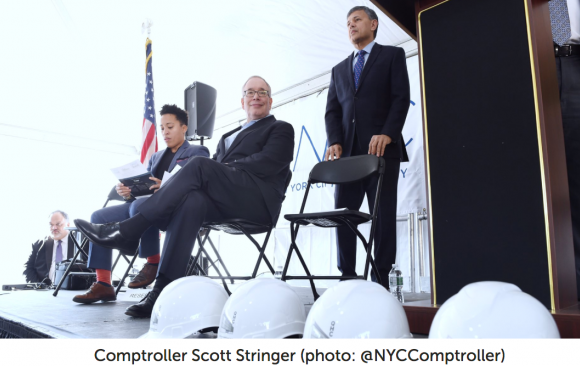


Last week, The New York City Comptroller Scott Stringer took aim at a pressing issue facing New Yorkers: housing affordability, and unveiled a new plan headlined by a “universal affordable housing” proposal to require income-targeted units in every new development across the five boroughs.
Stringer, a Democrat who hopes to succeed Mayor Bill de Blasio in next year’s mayoral election, is also calling for fully using city subsidies to help create new affordable housing for low- and very low-income households, a new nonprofit land bank to better utilize city-owned vacant lots, and ending state-authorized tax abatements that he argues are not spurring enough affordable housing.
The comptroller’s overall plan, which also includes a component aimed at increasing home ownership in the city, is dubbed “Housing We Need,” and seeks to take a more comprehensive approach, he said, than the current piecemeal efforts that too often involve upzoning communities of color to add housing that accelerates gentrification and keeps the city racially segregated.
Universal affordable housing would be a “fundamental shift” in the city’s approach, Stringer stressed, more aptly responding to the affordability crisis, and requiring that 25% of all new as-of-right development with ten or more units is set aside for permanent low-income affordable housing.
“To make sure these units are actually affordable,” Stringer explained of his universal affordable housing idea, “they should all be set at an average of 60% of the Area Median Income, or a household income of $58,000 a year for a family of three.” To avoid how development has spurred or reinforced segregation, the proposal applies to developments in all neighborhoods “whether it’s in the Upper East Side or in East Tremont.”
Mayor de Blasio has had a 12-year, 300,000-unit affordable housing plan to build rent-regulated housing for people of a variety of income levels, and taking advantage of neighborhood zoning opportunities where local City Council members have been willing to negotiate. De Blasio’s approach, Stringer has long-argued does not utilize city dollars to subsidize enough housing for those who are most rent-burdened, many on the verge of losing their homes.
“Our affordable housing programs were meant to be an answer to New Yorkers being priced out of their homes,” Stringer said. “They were supposed to yield hundreds of thousands of affordable units. They were supposed to anchor communities against the growing costs of living in this city. Instead, they’ve reinforced unaffordability. Instead of solving the problem, we’ve made it worse.”
Over the last five-plus years since de Blasio released his original Housing New York affordable housing plan, Stringer office released an updated analysis showing “that the ‘affordable’ housing created by the plan is too expensive for at least 435,000 of the city’s lowest-income households,” and that only a third of newly constructed units in fiscal year 2019 were affordable for extremely low- or very low-income New Yorkers.
In a stark departure from the de Blasio approach, Stringer is proposing that “all of our current housing capital subsidies should be used to build housing for extremely and very low-income families.”
The comptroller is also adding to his regular calls to leverage “1,000 vacant lots owned by the city” to provide housing for the city’s lowest-income families. The comptroller's office put out a report in 2018 that said the city’s Department of Housing Preservation and Development (HPD) is dragging its feet on developing the city-owned vacant lots.
Stringer closed his Wednesday speech by addressing homeownership rates in New York City, which he pegged at 32% of housing and half of the rate of the rest of the country. Further, he added that less than 16% of home loans are granted to black and Hispanic borrowers despite the fact they make up the majority of the city’s population.
For more information watch this week's episode of Raising The Bar that discusses how predatory lending can impact home ownership:
The comptroller’s plan aims to help increase homeownership rates by giving tenants the right of first refusal to buy their building when it goes up for sale, waving property transfer and mortgage recording taxes for qualified first-time homebuyers, and expanding programs like HomeFirst and HomeFix, to provide “moderate- and middle-income homeowners with up to $40,000 toward down payments and loans for home repairs,” Stringer said. “Who is New York City for?” Stringer said. “Our answer is loud and clear. This is your city, and your city cannot be bought.” Stringer’s new plan adds the elements of universal affordable housing and completely redirecting all city capital dollars housing subsidies, among other planks.
***
Article repurposed with permission from Gotham Gazette
Full original Article by Katie Kirker, Gotham Gazette
Ben Max contributed to this article.